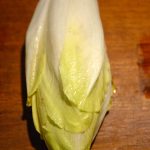
CHICORY
Chicory is related to Belgian and curly endive (frisee), radicchio, and Batavian escarole. The plants are each distinct, and yet some of the varieties resemble each other so strongly, the terms are often interchanged between plants. For this discussion, we will use chicory to include the entire group where similar, and while distinguishing any important differences.
When to Buy/In Season:
Chicory/Endive becomes bitter when exposed to heat and light, so the best season is fall and winter.
How to Select:
Look for leafy chicories, crisp and fresh, with no browning at the cut ends.
Chicories and endives are members of the genus Cichorium; chicories are perennials, while endives and escaroles are biennials. A few of the most popular types include:
Belgian Endive: actually a chicory, it’s common name is Witloof chicory. It’s best of used the same day it’s picked. Roots can be roasted for coffee.
Sugarloaf Endive: leafy, commonly referred to as chicory in England, while known as Sugarloaf endive in the US, and pain de sucre in France. It has thick, crunch leaves used in salads or to protect fish during cooking.
Radicchio: common in salad mixes, there are two types! The common type is grown in spring, with leaves cut off just above the crown in late summer. These types then resprout. Some are red-leaved and white veined, similar to a red cabbage, while others form a more elogated con-shaped head similar to the Belgian endive, while others form a loose head similar to a red romaine lettuce.
Escarole: a large-leaved chicory, also known as Batavian Full Heart. Green leaves can be unpleasantly bitter, so it’s often blanched and sold with a pale yellow to cream-colored center that is sweet yet bitter. When escarole reaches 12 inches across, growers tie up the outer leaves over the centers to blanch them. The outer leaves are occasionally harvested for soup, but the mild inner leaves are desired for fresh salads. The bottom core is also eaten.
Frisee: curly endive, or frisee, is used in summer months, but needs sun protection. It produces very finely cut, frizzy leaves that show up in mesclun mixes, salads, or can be cooked. Soil is trapped at the base of the leaves, so trim the bottom core off and rinse the peaves very well.
Organic Issues:
Conventionally grown chicory is considered heavily treated with pesticides.
Pesticide Issues:
EWG 2009 Dirty Dozen, not listed
How to Store:
Fresh:
Use the same day you buy it if possible. Refrigerate in crisper or wrapped in plastic bags to keep fresh; use within 1 – 2 days.
Photo Source: StimpsonJCat
Return to Buying and Storage Guides


